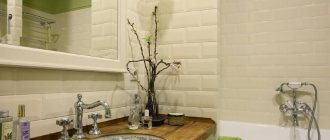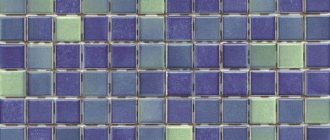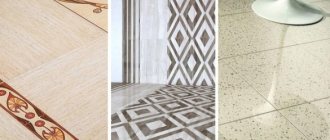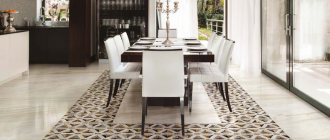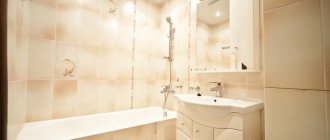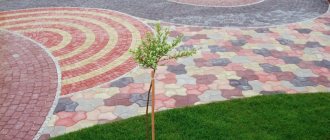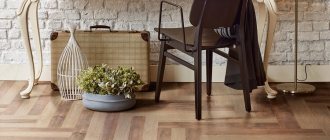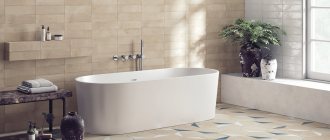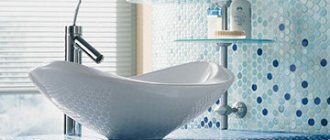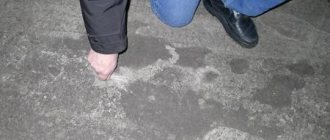Most people first buy tiles and then think about how to place them on the floor so as not to spoil the appearance. That’s why situations happen when, with a toilet 1 meter wide, they try to fit 2 tiles of 40 cm each and end up with a 10 cm trim at the edges, or even worse - leave 20 cm on one side. Although it was possible to put 2 rows of tiles in the same place 50 cm or 3 rows of 33 cm and get rid of undercuts. Once I came across a design project where there were 33x85 cm tiles on the floor. It is unclear where the designer got this size of floor tiles, because it does not exist in nature.
In this article, I will list the standard sizes of floor tiles to make your designs easier.
Due to technological features of production, the actual size may differ by 3-7 mm from the indicated one. That is, a 30x30 floor tile can actually have a size of 29.7x29.7 cm or 30.3x30.3 cm. It’s not worth calculating everything down to the millimeter before purchasing. Even in the same package, the sizes can be different, and this is especially common in cheap domestic collections.
Floor tiles can be divided into 2 categories - regular ceramic tiles and porcelain tiles. In essence, these are the same thing, but porcelain stoneware is stronger due to a different production technology: it is pressed under high pressure and fired at high temperatures.
Porcelain stoneware can withstand heavy loads, so it is used more often than tiles for flooring. But in small rooms with low load (toilet, bathroom) you can also lay regular tiles.
Where can large tiles be used?
Ceramic tiles of large sizes, in the photo an example of 3000 by 1500, made it possible to reduce the number of seams to 2, create a flowing picture of the design and make a bathroom and a bathtub in the same style.
Such a unique solution in a smaller format did not allow the creation of such a unique interior. Many manufacturers, sensing the direct benefit, decided that they could annually increase the size of the cost-effective material, which has led to the fact that today large-sized tiles are used in the decoration of ordinary apartments, private houses and cottages and its size will not surprise anyone. Photos of large tiles can be seen below.
Large floor tiles, even before they are laid, impress both the buyer and the installer; to carry such tiles you need to have special equipment (it can be rented) and at least two people. Buyers should check with the contractor if they have experience working with large formats, as they need to know that the glue needs to be applied in a certain way and be sure to use the SVP system and other specialized tools
Despite their special dimensions, large tiles can be used for finishing:
- Paul;
- Sten;
- Facade.
There are also tiles:
- Finishing;
- Decorative.
Particularly popular are ceramic tiles, which can be used for both exterior and interior decoration. The peculiarity of this material is that it can be used at low and high temperatures.
It is best to choose tiles taking into account operating conditions, since their price depends on this. If it is used in a dry room with a classic microclimate, then you should not overpay. True, if conditions require a special composition of the material, then you should not save.
Large size floor tiles
The floor is made of tiles or porcelain stoneware. Tile is a more familiar material for everyone, but porcelain stoneware is not entirely familiar to the modern consumer. This type of material is made from clay and is much thicker, making it more durable and wear-resistant, and can also be used to make larger tiles. Most often, such tiles are used in public places: shopping centers, hotels, offices, etc. Modern builders also use it to finish walls and floors in rooms with high humidity.
Laying tiles on the floor requires compliance with certain rules. The first of them is that the material must be selected according to size. The more accurate the size, the better. The fact is that cutting and adjusting can damage the tiles and make them unsuitable for installation, as chips will appear on them and their appearance will be lost.
To choose the right size of tile, you should first accurately determine its layout.
Large floor tiles are laid:
- diagonally;
- brickwork;
- directly.
In order to make the composition more attractive and each meter corresponds to the intended design, many experts use a variety of decorative inserts or panels. Some manufacturers offer entire sets that consist of tiles of different sizes, which allows you to create an interesting pattern or ornament. Before purchasing finishing material, it is best to first make a virtual layout of it, this will help save money and time.
Large-sized floor tiles provide maximum protection against fungus, against injury from the edges of tiles at the junction of tiles and create unique interior solutions
It is worth knowing that the size of the tile most often has deviations in the declared data, that is, it is not always accurate. This depends on the characteristics of its production. When fired, clay can behave differently and therefore it is almost impossible to maintain the most accurate parameters; most often they are approximate. To ensure that the tiles lie harmoniously and deviations are unnoticeable, there is such a thing as seams that are filled with grout (special composition).
It is no coincidence that we are attaching this photo; large-sized ceramic tiles must be laid using SVP and, of course, by experienced craftsmen who understand and know how to prepare the surface before laying
Selecting a mixture for attaching to the base
With this coating, it is necessary to carefully approach the choice of glue, since it will determine how reliably and long the material will adhere to the wall or floor. You can use tile cement mortar with an increased adhesion rate. Adhesion refers to how strong and strong the adhesion of the tile to the base will be.
Increased tenacity will ensure a longer service life. It is also necessary to select a mixture in which the elasticity indicator is well selected, since the glue for this material must be elastic, otherwise after a few days everything will simply crack under the heavy weight and temperature changes. If you are using large tiles, then you can use the same adhesive as for standard-sized tiles, but with a slightly different layer of mixture applied to it - it should be a little thicker.
The packaging of such compositions clearly states that they are intended specifically for non-standard, so to speak, “XXL” coating sizes. It is best to choose cement mixtures, since they are one of the most reliable and proven options. But you can also use paste mixtures - one-component or two-component. Look at the situation and your premises. For a large working surface area or when laying on the floor, it is better to use cement mixtures; for a small area - one or two-part ones.
Large size tiles for walls
Large ceramic tiles require a special adhesive composition, as their weight is quite large. It is also worth considering that gluing such tiles to a crooked or untreated wall is not recommended, as this can end in disaster.
If the room is not large, then you should not use large tiles. This material is more suitable for swimming pools, large bathrooms, shopping centers, shops, cottages and private homes. There are design options when small tiles can be combined with large ones. It looks very nice and modern.
If you want to visually expand the room, you can use large rectangular tiles that are laid horizontally. You can also lay out the material in the form of entire compositions that will create a special atmosphere.
Wall tiles must have high levels of moisture resistance and hydrophobicity. That is, the material must tolerate wet rooms well and absorb water. Also, the tiles must be resistant to the aggressive effects of synthetic detergents.
Wall tiles are:
- Glossy. This material requires special care, as plaque and stains may remain on it. But such tiles are very smooth and perfectly reflect directional light;
- Matte. This material is easy to care for and gives the room coziness and expressiveness;
- Embossed. Such material can have any surface on which a drawing, pattern, or ornament is applied.
Wall type tiles can have a universal and straight edge shape. Straight-edged material is laid using plastic crosses, which are designed to fix the joint width. The universal edge is laid end-to-end by specialists.
If your wall should be decorated with tiles, then when choosing, you should pay attention to the following factors:
- Resistant to temperature changes. This criterion especially applies to the bathroom, since here very often heat can alternate with relative coolness;
- Quality of material. The tile must be free of chips, cracks and other defects;
- Strength. When choosing a material for cladding, it is worth considering how resistant it is to various chemical elements and mechanical damage from the outside;
- Dimensions. This parameter will help you calculate exactly how much material will be needed depending on the size of the room and the designer’s ideas.
Large sized wall tiles are used for tiling bathrooms, cabinets, terraces, offices, living rooms, shops and much more.
The large tiles in this photo clearly demonstrate how to achieve maximum simplicity in the interior. This would not have happened with a smaller size...
Finishing work
You must wait a day before starting these steps. The day has passed. Now all you have to do is pull out the crosses from the grooves of the seams. It is necessary to seal the joints between the tiles with something. It’s good that their size is very large - there are fewer seams and they themselves are wider and longer. Standard caulk will always work for this, but silicone or resin caulk can also be used.
Wait another 2-3 hours, after which you can wipe the coating with a rag or sponge - just clean it from dirt that inevitably appears after repair work. That's all. Easy work for you and high-quality results!
Advantages
Large tiles have many advantages:
- Maximum environmental friendliness: the tiles are completely safe for human health and do not harm the environment. It does not emit harmful substances and does not cause allergies.
- Long service life: if all the rules were taken into account when selecting a special glue and the correct conditions of use, the tiles can last a very long time, which can last for decades.
- High decorative qualities: porcelain stoneware facing material can embody any design ideas. The tile always looks very expensive and does not lose its appearance throughout its entire service life.
- Fire resistance: Ceramic tiles are those materials that do not burn, do not melt, and cannot be a source or material that supports combustion. In this regard, it can be used in fireplace and boiler rooms.
- Resistance to chemicals: tiled floors and walls can easily withstand the aggressive effects of various chemicals, which include detergents. True, it is worth considering the degree of class when choosing: D – does not have strong stability, AA – is the most stable.
- Good electrical insulation qualities: tile material is not a conductor of electricity.
- It perfectly resists the effects of many contaminants: the tile does not absorb any kind of dyes, does not accumulate dust, and is easy to care for and simply wash.
In connection with all of the above, we can conclude that ceramic tiles have many positive qualities. All remaining questions can be answered in the video below.
